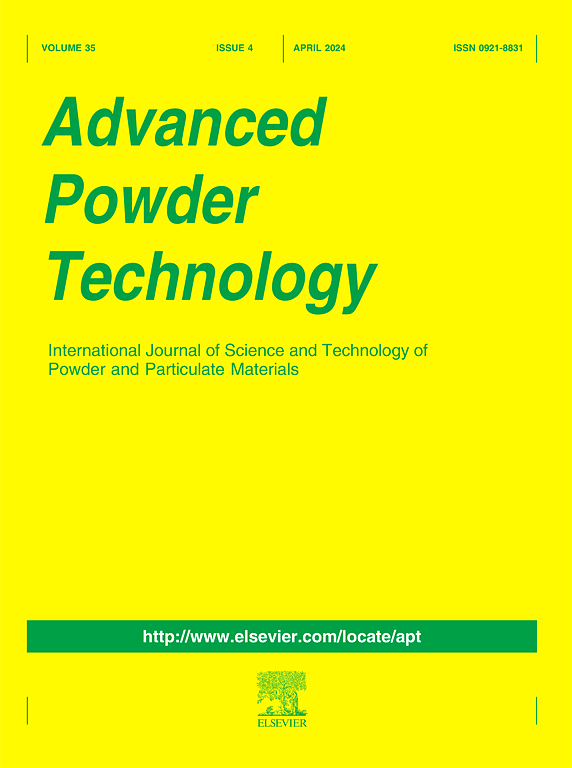Bam@MIL-125/Ag evaporator: Synergistically boosting evaporation and photodegradation for Holistic water management
IF 4.2
2区 工程技术
Q2 ENGINEERING, CHEMICAL
引用次数: 0
Abstract
Here, a biomass-based composite interfacial evaporation system utilizing a Ti-MIL-125-NH2/Ag (Ti-MIL-125/Ag; MIL-125/Ag) catalyst was successfully developed, which innovatively achieved synergistic enhancement of photothermal conversion and photocatalytic degradation. Initially, the precisely engineered Ag nanoparticles-modified Ti-MIL-125-NH2 significantly enhanced visible-light absorption capacity and charge carrier separation efficiency. Furthermore, a Bam@MIL-125/Ag three-dimensional porous interfacial evaporator was constructed using eco-friendly and low-cost bamboo substrate through the sodium alginate gelation. At a height of 1.5 cm, 5 wt% of Ag loading, and a content of 20 mg of Ti-MIL-125/Ag in the Bam@MIL-125 evaporator, the Bam@MIL-125/Ag system under 1 kW·m−2 simulated sunlight demonstrated an evaporation rate of 1.45 kg·m−2·h−1 and a solar-to-vapor conversion efficiency of 81.2 %. Notably, leveraging photo-generated free radicals from Ti-MIL-125/Ag, the Bam@MIL-125/Ag evaporator achieved efficient removal (98.67 %) of volatile organic compounds (VOCs) in water through the photocatalytic degradation process. Furthermore, when operating continuously for 56 h in a 3.5 wt% NaCl solution, the Bam@MIL-125/Ag evaporator maintained an evaporation rate above 1.4 kg·m−2·h−1, demonstrating excellent stability, salt resistance, and heavy metal removal capabilities in practical applications. This work provides an innovative strategy for designing MOF-based evaporators that combine high-performance water production with advanced purification functionality.

Bam@MIL-125/Ag蒸发器:协同促进蒸发和光降解,实现整体水管理
本研究成功开发了一种基于Ti-MIL-125- nh2 /Ag (Ti-MIL-125/Ag; MIL-125/Ag)催化剂的生物质复合界面蒸发系统,创新地实现了光热转化和光催化降解的协同增强。最初,精确设计的Ag纳米颗粒修饰Ti-MIL-125-NH2显著提高了可见光吸收能力和载流子分离效率。在此基础上,以低成本、环保的竹材为基材,通过海藻酸钠凝胶法制备了Bam@MIL-125/Ag三维多孔界面蒸发器。在1 kW·m−2模拟光照条件下,Bam@MIL-125/Ag系统的蒸发速率为1.45 kg·m−2·h−1,太阳-蒸汽转换效率为81.2%,在1.5 cm高度、5 wt%的Ag装载量和20 mg Ti-MIL-125/Ag的条件下,Bam@MIL-125/Ag系统的蒸发速率为1.45 kg·m−2·h−1。值得注意的是,Bam@MIL-125/Ag蒸发器利用Ti-MIL-125/Ag光产生的自由基,通过光催化降解过程有效去除水中挥发性有机化合物(VOCs)(98.67%)。此外,当在3.5 wt% NaCl溶液中连续运行56 h时,Bam@MIL-125/Ag蒸发器的蒸发速率保持在1.4 kg·m−2·h−1以上,在实际应用中表现出优异的稳定性、耐盐性和重金属去除能力。这项工作为设计基于mof的蒸发器提供了一种创新的策略,该蒸发器结合了高性能的水生产和先进的净化功能。
本文章由计算机程序翻译,如有差异,请以英文原文为准。
求助全文
约1分钟内获得全文
求助全文
来源期刊

Advanced Powder Technology
工程技术-工程:化工
CiteScore
9.50
自引率
7.70%
发文量
424
审稿时长
55 days
期刊介绍:
The aim of Advanced Powder Technology is to meet the demand for an international journal that integrates all aspects of science and technology research on powder and particulate materials. The journal fulfills this purpose by publishing original research papers, rapid communications, reviews, and translated articles by prominent researchers worldwide.
The editorial work of Advanced Powder Technology, which was founded as the International Journal of the Society of Powder Technology, Japan, is now shared by distinguished board members, who operate in a unique framework designed to respond to the increasing global demand for articles on not only powder and particles, but also on various materials produced from them.
Advanced Powder Technology covers various areas, but a discussion of powder and particles is required in articles. Topics include: Production of powder and particulate materials in gases and liquids(nanoparticles, fine ceramics, pharmaceuticals, novel functional materials, etc.); Aerosol and colloidal processing; Powder and particle characterization; Dynamics and phenomena; Calculation and simulation (CFD, DEM, Monte Carlo method, population balance, etc.); Measurement and control of powder processes; Particle modification; Comminution; Powder handling and operations (storage, transport, granulation, separation, fluidization, etc.)
 求助内容:
求助内容: 应助结果提醒方式:
应助结果提醒方式:


